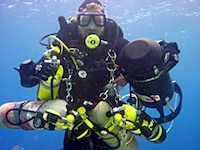Buying diving equipment: What first, and what exactly?
You have started diving and realize that after all, you have got some money to put in you new activity. So… unless that money is unlimited, you are likely to be confronted with a lot, and I mean A LOT, of choices to make. Typically you will ask your instructor/buddy with more experience, and you will get the standard answer:
figure out which kind of dives you want to do, and then buy stuff accordingly
but as we all know, that answer is totally useless. There are several reasons for that. Just think in your ideas on diving twenty dives ago, when you started. Probably you thought that you were taking a course for diving now and then on a holiday… and in the meantime you have discovered that the waters close to home are also great. Or you were totally freaked out by the idea of being 15 meters depth, and now 30 above you are no concern at all. The more you dive, the more your diving horizons expand. Diving gear does not come cheap, and there is a good reason for that: your life depends on it. So you want to make choices that without wasting money maximize your security and comfort under water. This is what the following lines are about.
Start with the most personal choice
A dive mask is probably the most personal piece of gear that you will have. Contact with eyes, nose and mouth is, after all, an intimate business. Have you got lenses? then your first priority is to order a mask with correction. The difference matters, and having contact lenses underwater is not a good idea. Old fashioned divers prefer small masks, under the idea that from a small space is easy to get rid of water seeping in, or air getting compressed. My mask is small. All the same, nowadays there is a trend to increase the volume and get a broader view-range. I would still go for small, but a big mask is no mistake.
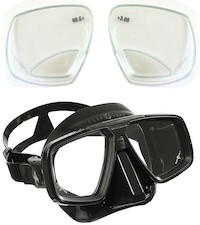
my choice 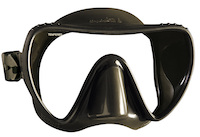
not wrong either
Second choice, to better float
Most divers today use a stab jacket. I just don’t get it. Just as with other flotation devices once upon a time used, technology today offer superior choices. So the first part of this advice is: forget the jacket! My choice is or a wing, or a side-mounted harness. Side-mount is a whole thing growing recently, so I’ll write about it at the end. Let’s focus on the wing. People is likely to ask you, when you ask for a wing, if you are going to become a technical diver. The definition of technical diving (dive with a ceiling that you can not go through whenever you want) is scary enough to make say pretty much every other beginner diver “no!”. But the idea that a wing is exclusive for technical diving is as silly as to say that ABS breaks should only be on race cars.
The thing of a wing is that the air that keeps you stable in the water is not all around you, but behind you. That makes for your stability to be greatly increased. The air that you put in your wing is constantly driving you to stay horizontal, and that is how you want to be, to move with minimal effort. It is true that most wings do not have the pockets that stab jackets have, but if you really need to carry stuff under water without having it hanging around, there are plenty of solutions using the wing d-rings. Better than a pocket actually, since you will not find yourself fighting with a hard to reach zipper underwater. Another advantage of a wing is that you have to use it with a backplate, which can be made of steel, so it will take some (or all) of your lead out of your hips.
I do think that “less is more” so I expend 100 euros in a brand-less backplate, less than 50 in the webbing needed for attaching it to you (d-rings included) and couple of hundred euros more in the bladder itself. That gets you to 350 euros, which is the price of medium quality jackets. You will be getting best wing configuration for that. Of course, in shops they will try to sell you wing setups already put together by 500 (up to 1000) euros. Ask yourself if you need to buy it assembled for you… and if that is worth the extra money.
A word about the bladder. Size matter! At this level you want to dive with a long-12 lts steel bottle. (more on why under). For such bottle, a donut wing of about 40 lbs is quite enough. On holidays you will be able to put a 15 lts bottle on it if you want. I myself wanted to buy Halcyon or OMS, both brands with a long tradition in making wings. Talking with owners of those told me that their reputation was (few years ago) unfounded. I ended buying a tecline, a starting polish company that puts lots of thinking in what a diver needs. Their enthusiast designers (to whom I talked) are associated with GUE, which is a good thing when talking about well thought equipment. Last but not least I bought aluminum profile from a shop close by my home and fashioned my own “single cylinder adaptor” (since wing-backplates are made for double cylinders) for 7 euros, but if you want to buy the pre-made one by 80, that is also possible.
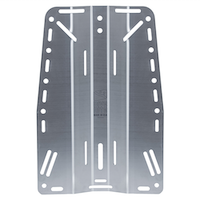
the backplate… 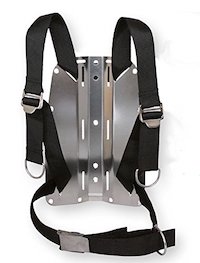
with webbing 
a bladder… 
and all together
Well, the air container then.
It is kind of surprising that so many kinds of bottles exist. Probably that is the nature of market driven economies :-). Anyhow, anything under 10 liters is unlikely to be enough to carry a nice long no-decompression dive with enough reserve air. 15 liters is mostly too much for non-deco dives, and too small for deco ones. So we get the 12 liters. Now, the most common 12 liters bottle around is the so called short-12, which is one that I would not buy. The advantage of a long 12 is that its weight is more distributed along your whole body. To reach the valve of a short 12 with your hands under water, you will have to put it so high in your back that it will feel as if you will be starting a somersault.
There is another great advantage in using a long 12. If it happens later that you want to go on with more demanding dives, it is quite standard to dive with double 12’s. Nobody uses a double short 12, since instability becomes unbearable. So, if you happen to go later in this direction, you will already have half of your bottles, instead of having one that you will not use again… And if you don’t, you will still be diving with plenty of air and stability.
From 200 to 1, the regulator
The regulator is the most expensive part of your equipment, and the most crucial too, since it is the one that let you breath. Let’s start with a statement:
today it is almost impossible to buy a bad regulator
This is a true statement. And yet, it is not enough for me. It’s direct conclusion is that you could walk into a shop, get the cheapest regulator, and be happy for the coming years. Be aware, some of my friends with several hundreds of dives logged are still happy with their cheapest Mares. So it is possible. And yet, I did (and do) otherwise.
I learned to dive with a Pacer 150, from DACOR. That brand was the one to invent balanced regulators, and mine (33 years later) still works today. So when I wanted to buy a new one to start diving here in The Netherlands, I tried to buy DACOR. Alas, the brand was acquired by Mares, the original Italian and now subsidiary of the Head conglomerate of sport equipment. Back in 2009 you could still get some Dacor in few shops, but were being discontinued. So I bought the best Mares available. Few years later, all my technical divers friends seems to be using Apeks, and I have considered to sell my Mares Abyss and buy Apeks. Haven’t decided yet. Still, for decades the choice for demanding divers seems to have been Scubapro. And it is hard to talk bad about the top Aqua Lung models, the brand started by Cousteau to popularize his invention… the regulator! So, what should be your choice?
My own process tells me to get the best regulator out there. I don’t think that to save money is a good idea here. And yet, that is the first advantage of Apeks, money. Even though they offer different models, they are all the same inside… so one of the cheapest Apeks will already give you the same quality that the most expensive. On top of that, Apeks is the only brand that offers maintenance courses to lay people. Which means that if you take it, you will be able to save hundred-plus euros each year in paying technicians to maintain your regulator. So: If all “advanced divers” seems to agree on Apeks, and it saves you money on the medium-long run… why to use other brand?
I must say that I am still very happy with my Mares Abyss. My wife uses AquaLung, and my son goes with Scubapro. I have yet to hear the first complain about a Scubapro MK25, or an Aqua Lung Legend. If you are a person to follow the crowd, here is a rank that I have extracted from few years of conversations with european divers:
Mares is italian and is not reliable (I think bull in general and just wrong for Abyss)
Aqua Lung is french, maybe ok, but not quite the real thing (again bull and probably wrong for Legend)
Both Mares and Aqua Lung are recreative brands, insufficient for demanding dives (nonsense)
Scubapro is just good (yes for top model, and yet why there is so much change in their second stages?)
Apeks is the thing to have (probably true, but is it really better than Abyss, Legend or a 700?)
This is, of course, about mainstream brands. Right away allow me to make a confession: I know nobody diving with a top Cressy, so I have no opinion about them. Mainstream opinion here in NL is that they are worthless… but it might be like the opinion about Mares, just unfounded. Few people I know go for Poseidon. Those are very simple regulators, really cool if you go for repairing your own, your own being a very weird looking thing. Also due to their internal simplicity, if they blow, they blow without warning, no hissing before… Moreover there are other top brands popular in the states that have not made it in here, so I have no opinion whatsoever. I am talking about Hollis, Oceanic or Atomic. No clue. My friends of Tecline begun to sell regulators very recently, but I only know one person that have one… bought weeks ago. Insufficient data to go.
And if the brands are covered, then what to buy? first stage, second stage and octopus? Nope. Get yourself two first stages, and two top second stages. Which will imply that you set a double valve in your cylinder, by the way.
To start with, the so called octopus are second stages of lower quality. I can not imagine why would you want to give to your buddy in trouble a sub-standard regulator. Would you like that your buddy saves some money in the equipment that you would use in emergencies? So I have two equal second stages.
if you dive in NL, even in the summer you will be diving under 10 degrees celsius which is the minimal temperature for regulators fulfilling EU standards. Get yourself a first stage that is isolated from the environmental water, and a mostly metallic second stage (which is the argument for going for the top models of AquaLung/Mares/Scubapro). I personally think that the Glacia from Aqua Lung is a device created to extract extra money from the unknowing. So if going Aqua Lung, I would stay with Legend even if you frequently dive under ice.
Then, I think that you have to have two first stages, and not one. The point here is that independency of equipment is crucial in case of failure. If one of your regulator fails, you can just close its valve, stop loosing your air, and use the other. Mind me, most divers today claim that this is only needed if you dive “technical”. I am willing to argue the point if you only dive in shallow warm seas… But I don’t think it is arguably when diving in The Netherlands, where every other dive outside zeeland will get you under temperatures that might freeze your first stage by simple adiabatic decompression. I think that to dive with equipment that is not sealed is irresponsible, and without double first stages foolish.
I am fully aware that my advice here is not standard. Buying a wing as I advised, you are cheaper than the mainstream advice. The difference of prices in cylinders is not relevant. But my regulator choice is more expensive than average. An Apeks set as I describe will cost you between 600 and 700 euros. Other brands will cost you more. People will advice you to go with cheaper options, with sets that start at 400 or 500 euros for one first stage, one second stage and an octopus. I would be more than pleased if you understand the reasons behind my advices for regulator (top model of brand of choice, first stage isolated from environment, two of them, two equal second stages) and make your own choice. My email is widely known, so do not hesitate to ask for details and options.
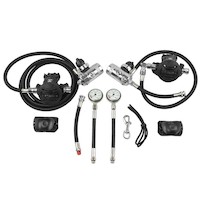
We see, we breathe and we float… but how do we move?
There is some discussion with the kind of fins that you should have. I moved around for years in long things. When my Avanti (yes, I had an emotional bound with Mares, i know) got so soft that they really did not work anymore, I bought a cheap imitation of the well known jet fins of Scubapro. So should you. The original model cost about 150 euros, mine costed me 30 second hand.
The reason is that plenty of fins are out there to swim or faster or with less effort. The first is plainly wrong for scuba diving. You want to move as slow as possible. And fast fins tend to be long, which will make harder for you to make short turns (which is what you want to do not only inside a tight wreck, but also to see that pretty reef fish trying to hide from you). Then, the whole idea of fins that allow you to move with less effort only shows that we people are suckers for smart advertisement and weird looking things. Every other human should know that energy is not created or destroyed, only transformed. So unless you are looking at a scooter, there is no way that some design will make you expend less energy than a simple short and hard fin. If you want to make less effort, that is a great idea: go slower! fins designs to make you finning softer will actually demand more energy from you for the same amount of movement: All those designs have hinges (just giving you a softer blade) or are split (same effect). And they all force you to use more muscle power for the same amount of movement, since they are less efficient transmitting your muscle movements to the water.
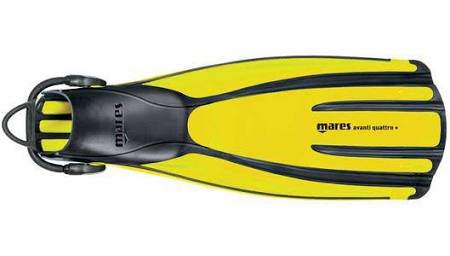
not wrong 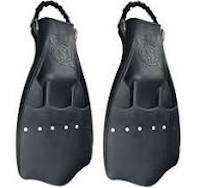
yet my choice…
But how long and how deep?
Once upon a time, when I started diving, the whole idea of a decompression table was quite foreign to our caribbean coasts. A dive had two turn points: when my aluminum bottle started to push me up, or when I had to pull the reserve wire attached to the main valve. That was how long we dived. Nowadays we have other standards, which probably put beginners out of harm way. Crucial to them are not only decompression tables, but their continuous implementation in personal computers. As such a dive computer is something that I would not dive without. I will skip here the whole discussion in which some old fashion divers still today claim that it is safer to dive following a table than using a computer: such position is not only wrong, but is also evidence of brain laziness. You need to have a computer. Question is, which one?
Differently than other pieces of equipment here described, I can not say that a top computer is just one or two hundred euros more expensive than her cheaper sisters. The computer that a diver will have in her wrist to dive the Britannic (the sister ship of the Titanic, sleeping at the border of autonomous scuba diving, some 150 meters deep in Greece) is likely to cost some 1200 euros, meanwhile the cheapest Suunto instrument (150, 200 euros) is already quite enough for most dives. When thinking about diving computers, until recently you were bounded to pay some for a starter model, and then pay a lot more for advanced instruments if needed be.
That has changed recently. The people at Dive-soft has come with a computer that is reasonably cheap (I believe 300 euros), which hardware has all what a most demanding dive would want, oled display among others. So buying it, you get all what you need (and then some) to start diving. If you want to use such computer with ean gases, or with trimix, you have to pay for upgrades in the software. So you would be having a top computer from the start, without having to pay for the functionality that you are not yet using. When and if you need it, then you pay it, without buying a whole computer again. That is what I would buy today, had I no computer whatsoever.
My first computer here in The Netherlands was a Suunto, the cheapest model (gekko in 2009). I know Suunto compasses since my hiking days, and they are reliable tough instruments. After having couple of years diving with my gekko, I was tricked to upgrade to a D4i by an offer that made me believe that I would pay just a little for the new one if trading the old (I paid more, my wrong). Take home message? think twice before buying things in offer. Anyhow, the air integration that the Suunto D series offer is quite a nice thing to have. Technical divers will tell you that it’s not a good idea to add failure points in your equipment. True, but I believe that the technology of pressure sensors is safe by now, and I still use an analog manometer per cylinder. It is nice to look at your bottle content in the same screen than show your deep and time. Disadvantage of Suunto models is that none of them can see more than one cylinder. And the computers of Divesoft do not come with integrated air. So my advice to you is to get indeed an Divesoft freedom and forget about reading gas in your wrist… but being aware that with whatever device that tracks deep and time, and calculate deco time (allowing gases with more than 21% oxygen, of course) you are on the safe side. But knowing that perhaps you want to go for advanced computers with one or more cylinders integrated in their screens.

ideal price value relation 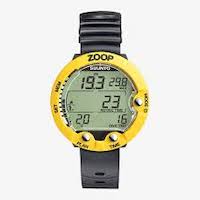
yet not wrong at all to begin
3000 plus words already… are we done?
Actually, we are. Other choices remaining are not so confusing, or critical (which wet suit? a standard Bare double 7 mm, probably any other double 7 is just as good. Dry suit for later if and when into deco diving) Since I started diving side-mounted I do not want to dive back mounted, so actually I should say: forget the wing, get yourself a side-mounted harness, and buy two cylinders right away. The rest of my advices here work out for side mounted. I have been saying that to plenty of starting divers… but it seems that it is too weird an advice. So here I will only mention it. Elsewhere online I have argued for side-mounted configurations (article in dutch), read that if interested. It seems that most people starts diving back mounted (get them to understand that a wing is better than a jacket takes already some convincing) and then they go side mounted. When you go that way, you will be able to trade your wing/backplate for a side-mounted harness. Or you might want to retain your wing to dive with people that do not deal easily with a strange configuration, and add the side mounted harness.
One good thing of my advice here is that you will not need to improve on equipment that you already bought. Standard advice today might end up being one or two hundred euros cheaper than mine, but then you have to expend some other several hundred euros one or two years later. And you will be using sub-standard equipment for a while. My advice is cheaper on the long run, and get you with top equipment from day one.
Wonder why I did not mention anything about lamps? Few years ago a good Hartenberger costed you more than a good regulator, so the whole issue was worth the thinking… but today you can get 1000 lumens wrapped on your wrist for 50 euros online, in lamps from non-descript brands made somewhere in china. Why wouldn’t you?
And with that… go and do some diving instead of reading such long texts!!
